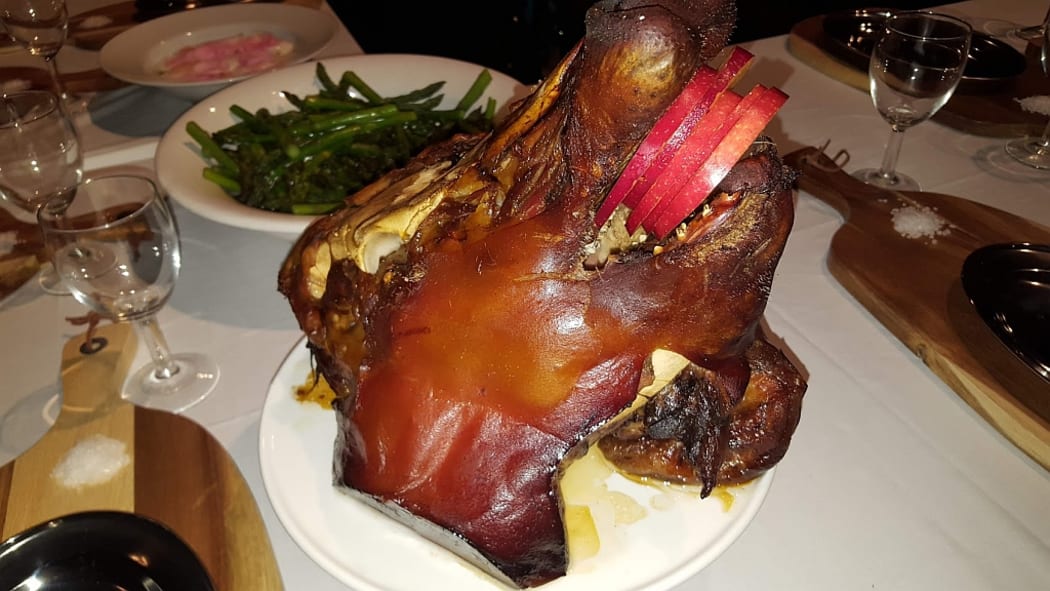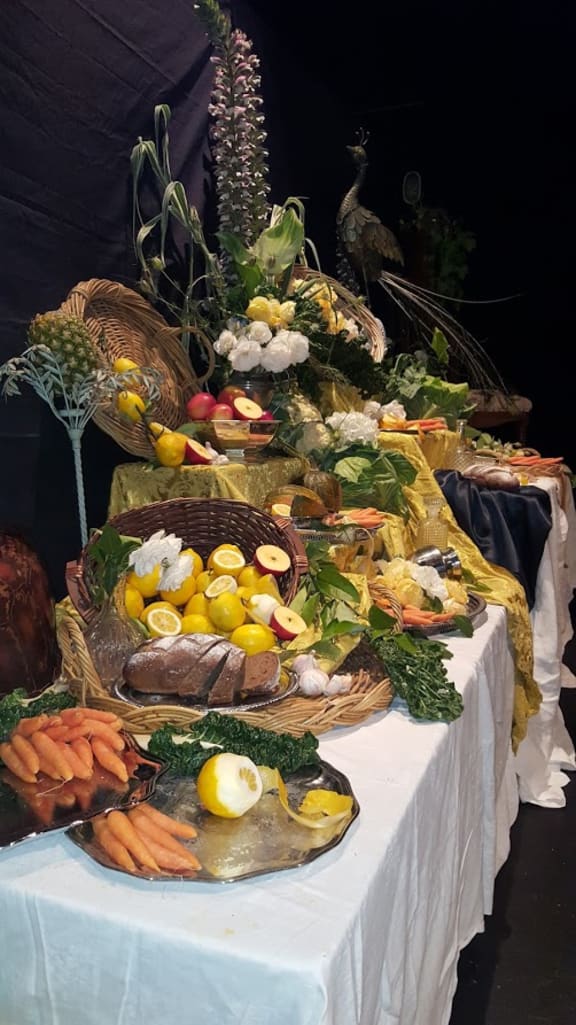Did you know that the tomato only became popular locally about 1920? Or that brussels sprouts and silverbeet didn't catch on until the 1930s?
Our national diet has undergone massive changes in the last half-century. Duncan Smith heads to the annual NZ Symposium of Gastronomy to find out why.

Baked Pig's Head at the Symposium of Gastronomy. Photo: RNZ
‘It’s a tough job but someone’s got to do it’ he said, giving me what I can only call a meaningful stare.
He stared for what seemed an uncomfortably long time.
My bottom lip trembled a little but I managed to suppress a deep internal shudder as my stomach churned.
I held his gaze and feigned ease.
‘Oh yes,’ I proffered. It caught in my throat and squeaked out like an aging choirboy.
‘I need you to go to the bay,’ he plowed on bullishly, ‘Napier, this coming weekend’.
‘Okayyy…’ My mind was racing; the bay, Napier, why me?
‘There’s something called The Symposium of Gastronomy’ he continued.
It’s in Napier next weekend and we think you’re the man to cover it.”
My visions of waking to the sight of a bloodied horse’s head nestled on the rice pillow beside me evaporated into the ether as I digested what the mission required of me.
I would have to spend a weekend in Napier with a group of friendly foodies listening to interesting presentations about food, the making of it, it’s history and what the food we eat it says about us. My tummy gurgled in a different way
“Mmmm … Symposium of Gastronomy.”

Photo: RNZ
This group of chefs, anthropologists, historians, food writers and foodies are interested in the history and philosophy of eating, meals, food and food-ways, and they are out to promote a better understanding of our culinary heritage.
They have been meeting annually since the year 2000 in different locations around the country.
They welcome anyone with an interest in food and eating (Me! Me!) to take part in the Symposium and to contribute to their journal The Aristologist.
The theme of this year’s symposium was ‘migrate’. It featured numerous and diverse papers and presentations.
Have you heard of Bee Nilson? She’s a graduate of the School of Home Science at Otago University (1931) who became a major food writer and educator and something of a celebrity chef in the UK in a career spanning the decades between 1935 until the early 1970s. Well, now I have!
There was a fascinating presentation by Bill Bryce about the endangered NZ long-finned eel, known as tuna, and the mysteries surrounding their migration and breeding.
It also covered the unique traditional food-gathering techniques used by Maori at Birdlings Flat in Canterbury.
Now their age-old knowledge is being used to assist in the eels’ conservation.
Our Australian cousins were in attendance including artist, Max Dingle, complete with an exhibition of his surrealistic food inspired collages; a paper on the power of Bondi Beach as a brand, and another about the history of airline food.
Of course, the timetable had been structured so that our morning and afternoon teas were created before your eyes and twitching nostrils.
We experienced freshly cooked English muffins, a delicious Polish treat of cabbage rolls, and the classic cucumber sandwich.
One presentation was Duncan Galletly’s personal memories of food from his childhood in England and then NZ.
It included the memorably awful boarding school food the highlight of which was the pie sandwich. Yes. One meat pie could make four pie sandwiches which were apparently delicious.

Game Pie. Photo: RNZ
The whole event was being held in a theatre so, naturally, the Saturday night banquet took on a Shakespearean theme complete with a stunning still-life arrangement of fruit and vegetables.
The food, all cooked to authentic period recipes included a magnificent whole roast pigs head, a turkey, leg of hogget, and a huge whole salmon.
Sumptuous, but with a downside – the Elizabethans didn’t do the fork thing so we had to eat our food with a knife and spoon.
Messy for us, the fork-educated. But the spoon worked well for dessert -authentic period nosh with syllabub and a form of junket. Magnificent.
My real reason for attending the Symposium was to gather material for a story for RNZ’s Eyewitness series about how New Zealand’s culinary landscape has been changing in the last half-century.
Did you know that the tomato only became popular locally about 1920? Or that brussels sprouts and silverbeet caught on in the 1930s and 1940s?
Imagine a vegetable shop today without capsicum, eggplant, broccoli and courgettes. Most of that kind of fare only became commercially available in the 1960s and 1970s.
The food we eat is central to our very existence and has a constantly evolving menu driven by innumerable factors.
“Hmmm … I wonder if I can volunteer to cover next year’s symposium…”
This story was produced using archival audio from Ngā Taonga Sound and Vision.


